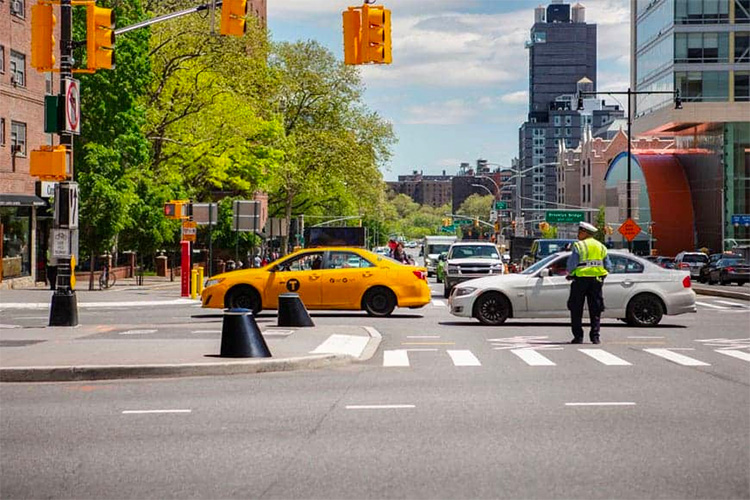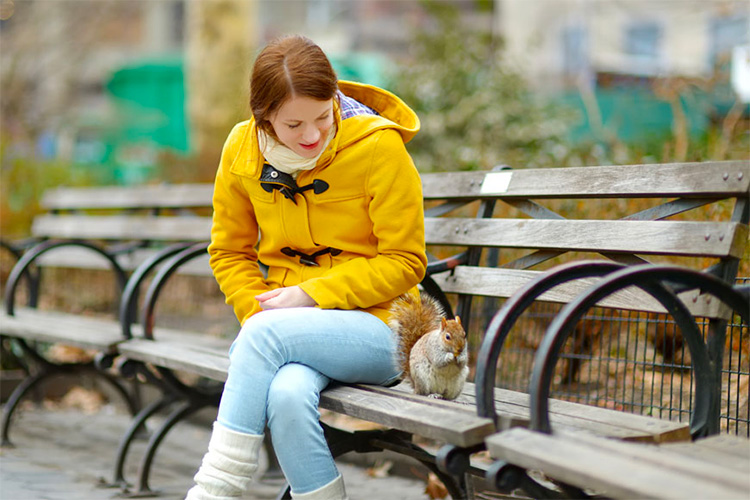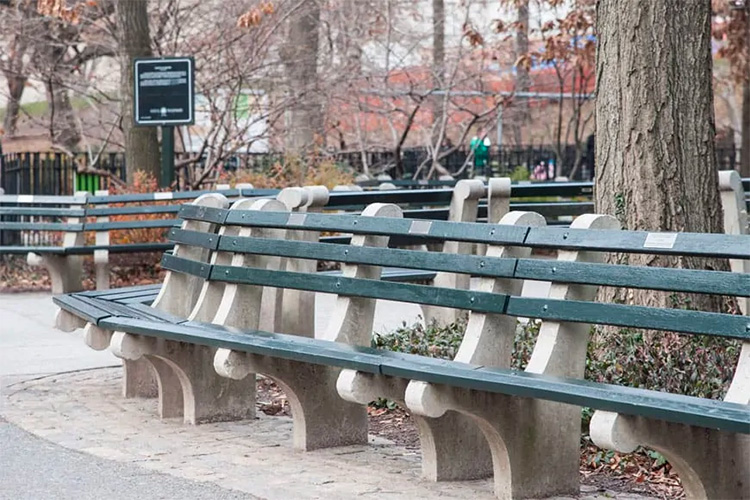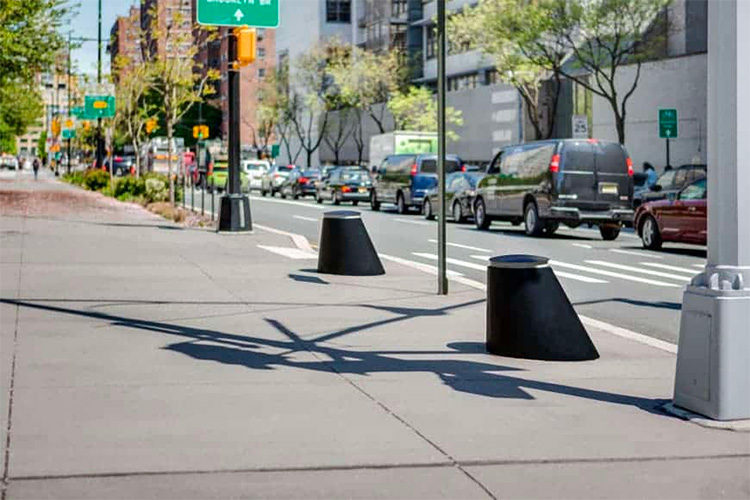Hardscape: Urban Design and the Outdoor Bench
September 3, 2021

Although NYC taxis have changed over the years, they are still a distinctive part of the streetscape.
The following content was originally published here. All photos courtesy of Relince Foundry.
Urban Design and the Outdoor Bench
What municipalities can learn from New York’s distinctive detail
The atmosphere of a location is built by a thousand small details. Some of it comes down to geography: the quality of light, plants in the ecosystem, and movement of air imprint even in the heart of a city. A city’s personality is also made of the materials and design of their buildings, common spaces, attractions, and amenities. What would London be without double decker buses? Or Hong Kong without junks in the harbor?
New York has many large iconic buildings—from the unsurpassed art deco of the Chrysler and Empire State buildings to the historic Brooklyn Bridge. Yet New York is also built on smaller scale design. Consider the green metal enclosures emblazoned with bright circles that mark the subway; the sidewalk cellar doors that open onto steep ladder-like stairs; the iconic city benches that dot Central Park. Many of these small atmospheric details arise from municipal laws, infrastructure, and volume purchasing. Although they may seem like small or practical details when they’re first installed, the look that arises from these choices shape the city for generations.
When small municipalities today are looking at the requisition of street furniture, their choices will similarly echo into the future, creating ambience and place that brands their city, as it grows.
Outdoor benches: social, cultural, and aesthetic
Outdoor benches are a central part of an urban identity. By having well placed benches, the city invites people out onto the street. Vibrant street culture creates a metro’s character.
Research has shown the presence of comfortable benches helps mental, physical, and social health, and the popularity of dedicated or commemorative benches shows that people agree. People love street furniture that makes a city into a home.
Seating is also a powerful tool for creating social landscape. A municipality that invites people to gather and interact is engaged in placemaking with their community. Such great spaces often attract tourism and clients to local businesses for a vibrant, engaged streetscape.
Bench design offers a hint of the character of a city. Are the benches artistic, plain, classical, or modern? Is the design hostile to some, or inviting to all? Where are the benches placed in relation to gathering places, amenities, and facilities?
New York City’s World Fair bench is seen throughout the five boroughs.
New York’s city benches
New York prioritizes liability, and so offers an example to other municipalities. Local government offers a “CityBench” program which invites the public to suggest locations for new bench installations. The program especially prioritizes transit areas, sidewalks near transit, and centers of activity: commercial districts, community centers, seniors’ centers, and other facilities. The ubiquity of benches in New York helps it invite people of all ages and abilities out onto its streets.
The World Fair bench
New York city has several popular bench styles, but the World Fair bench is one of the two most iconic.
Robert Moses, a city parks commissioner in the 30s, wanted to develop an aesthetic that would tie the look of the city together, throughout its many parks. He commissioned a bench design to be created for the 1939 World’s Fair. This “World’s Fair Bench” is found in formal areas in Central Park, as well as notable installations in Washington Square, Lindsay East River, and Bryant parks. The benches are also a place to rest on the boardwalks along Coney Island, Roosevelt Island, and the North Cove Marina. The precise geometry of the circular arms and half-circular feet reflect the art deco aesthetic popular at the time.
In Central Park, the wood on these benches is often painted green, but plain or stained wood is common in other locations. Original styles feature an X of bracing metal strips across the back.
The Chrystie-Forsythe bench
These Christie-Forsythe (wood-and-concrete) Benches were also designed in the 1930s.
Also developed in the 1930s was the “Christie Forsythe” (Chrystie-Forsythe) bench, known sometimes only as the “wood-and-concrete” bench. This bench is seen all over Central Park.
The NYC Parks board link suggests that “Christie Forsythe” is the correct spelling, but does not offer provenance of the name. Another prominent location for this concrete bench is also found at Sara D. Roosevelt Park, opened in 1934, between Chrystie St. and Forsythe St. in the Lower East Side. It is possible that the bench was originally developed for or installed at this site. Examples are found in other parks opened during the mid-thirties, like Orchard Beach in the Bronx. Although it is slightly less recognizable than the World Fair bench, it also is dotted around the city.
The Chrystie-Forsythe has a comfortable, laid-back style, often placed in rows so that many people can gather and lounge. The concrete looks like a bracket with a shaped flourish that holds sloped wooden slats. These are occasionally replaced with recycled plastic, but wood is still the most common replacement material.
Bollards and urban identity
Active streets require active transportation options, like bike lanes, pedestrian spaces, and transit. Bike lane bollards are one way cities create dynamic interaction with the streetscape. However, bollards can add to a city with both form and function.
The option to customize bollards, as is very common in the UK, can allow cities to take their branding to a new level.
Here again, America’s largest city takes the lead in branding.
Martello bollards both act as a barrier and a guide that can redirect vehicle energy back to the road.
New York’s bollards—a unique design
Function and form went into the design of some unique New York bollards, a solution the city found when looking for barriers that could act as recoverable traffic protection.
In North America, bollards are often installed to act like a fence, absorbing impact to slow or stop what is striking them. Another type of bollard, the bell bollard, is more common in the close quarters of British roadways. Bell bollards are often placed on tight corners and are designed to redirect energy, rather than stopping it. They catch the errant wheels of a vehicle making a tight turn and they return the vehicle back to the roadway.
Martello bollards are designed to act as both barrier and redirection. In New York, tight turns are less common than on British streets, but traffic density and shared space is a definite challenge. These bollards are therefore designed to both protect pedestrians, as impact absorbing bollards, and to nudge vehicles back to their appropriate places when they wander. Inspired by the densely-walled, protective Martello forts that marked coastal locations across the British Empire, these bollards have a larger profile than a bell bollard. This allows them to stop a vehicle should their directional nudge fail.
These bollards are being installed along areas of heavy traffic and can be seen dotting the Manhattan-side approach to the Brooklyn Bridge.
@reliancefoundry #reliancefoundry #bollards
Company:  Reliance Foundry Co. Ltd.
Reliance Foundry Co. Ltd.
Product: Bollards > Decorative/Architectural
Of: Reliance Foundry Co. Ltd.
Source: https://www.reliance-foundry.com/blog/outdoor-bench-urban-design
Tags:
Bollards
Thoughtful hardscape design can turn the concrete jungle into comfortable human habitat (July 21, 2021), Designer…Traffic Guides? Unique Spaces, Custom Bollards (June 25, 2021), Flexible Bollards vs. Traffic Delineators: which traffic safety equipment will provide best value for your application? (May 17, 2021), Channelizers and Flexible Bollards (May 7, 2021), A Complete Guide to Attractive Security Perimeters (March 15, 2021), Bollards for Campus Safety: A strategy for successful traffic management (February 17, 2021), Decorative Concrete: From Buildings to Bollards - Whether Béton brut, smooth and polished, or glossy aggregate, concrete can be beautiful (December 11, 2020)
Design
Furniture
Urbastyle features concrete street furniture that is designed to be accessible for all (June 14, 2021), Social distance seating: portable cubicle seating systems for multipurpose venues (June 9, 2021), Custom bench adds to fire amenity (April 26, 2021), The Village of Slocan - Celebrating a Sense of Place (April 23, 2021), Bleachers And Theater Seating (January 20, 2021), Top five tips for creating a rooftop deck (December 18, 2020), Historic Crossroads (November 20, 2020), Create an outdoor workspace | design tips & furnishings selection (September 25, 2020), Pocket doors can help create a more peaceful, organized home with clean, concealed storage (September 21, 2020), Lofty Series trash receptacles offer a sleek option to enhance the beauty of your space (August 26, 2020)




